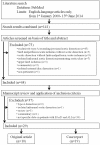Lower limb malperfusion in type B aortic dissection: a systematic review
- PMID: 25133098
- PMCID: PMC4128931
- DOI: 10.3978/j.issn.2225-319X.2014.07.05
Lower limb malperfusion in type B aortic dissection: a systematic review
Abstract
Background: Lower limb malperfusion (LLM) syndrome occurs in up to 40% of complicated type B aortic dissections (TBAD) and in up to 71% of TBAD with malperfusion syndrome. This syndrome is associated with higher 30-day mortality. The aim of this systematic review was to provide clinical and procedural data of patients with LLM syndrome secondary to TBAD.
Methods: The PubMed database was systematically searched from January 2000 to June 2014 for English-language publications reporting on demographic data of patients with LLM secondary to TBAD.
Results: A total of 29 papers were included (10 original articles and 19 case reports), reporting on a total of 138 patients (mean age =58±12 years; male =87%). Lower limb complications developed in acute and chronic TBAD in 134 (97%) and 4 (3%) cases, respectively. LLM presented with acute limb ischemia in 120 (87%) patients. Bilateral clinical presentation occurred in 56% (40/72) of cases. LLM was the only clinically detected malperfusion in 52% of cases (44/84). In 40% (35/84) and 25% (21/84) of cases, LLM was clinically associated with renal and visceral malperfusion, respectively. Radiological imaging showed renal, celiac trunk and superior mesenteric artery involvement in 53% (47/88), 31% (27/88) and 34% (30/88) of cases, respectively. Medical, surgical and endovascular treatments were performed in 22 (16%), 51 (37%) and 65 (47%) patients, respectively. Thirty-day morbidity was 31% (13/42) and 46% (6/13) following surgical and endovascular treatment, respectively. Thirty-day mortality was 14% (5/36) and 8% (2/26) following surgical and endovascular treatment, respectively.
Conclusions: LLM syndrome secondary to TBAD usually developed during the acute phase and, in most cases, presented with acute limb ischemia. Bilateral clinical presentation occurred in more than half of cases. Renal and visceral malperfusion were frequently associated with lower limb flow reduction but LLM was the only clinically detected malperfusion in more than half of patients. Surgical fenestration was burdened with significant complication rates and 30-day mortality. Endovascular procedures showed lower mortality but complication rates remained high.
Keywords: Type B dissection; acute limb ischemia; lower extremity; malperfusion.
Similar articles
-
Surgical and endovascular repair for type B aortic dissections with mesenteric malperfusion syndrome: A systematic review of in-hospital mortality.JTCVS Open. 2022 Aug 8;12:37-50. doi: 10.1016/j.xjon.2022.07.012. eCollection 2022 Dec. JTCVS Open. 2022. PMID: 36590716 Free PMC article.
-
Masquerade presentation of acute type B aortic dissection as isolated acute limb ischaemia treated with endovascular fenestration with angioplasty: A case report.Int J Surg Case Rep. 2022 Mar;92:106857. doi: 10.1016/j.ijscr.2022.106857. Epub 2022 Feb 25. Int J Surg Case Rep. 2022. PMID: 35248883 Free PMC article.
-
Midterm Clinical Outcomes of Endovascular Treatment for Acute Aortic Dissection with Malperfusion Syndrome.Vasc Specialist Int. 2024 Jun 7;40:17. doi: 10.5758/vsi.240006. Vasc Specialist Int. 2024. PMID: 38845442 Free PMC article.
-
Open fenestration for complicated acute aortic B dissection.Ann Cardiothorac Surg. 2014 Jul;3(4):418-22. doi: 10.3978/j.issn.2225-319X.2014.07.08. Ann Cardiothorac Surg. 2014. PMID: 25133107 Free PMC article. Review.
-
The Importance of a Multidisciplinary Meeting for Patients with Uncomplicated Type B Aortic Dissection.Ann Vasc Surg. 2025 Mar 8:S0890-5096(25)00133-5. doi: 10.1016/j.avsg.2025.03.001. Online ahead of print. Ann Vasc Surg. 2025. PMID: 40064288 Review.
Cited by
-
Application of Machine Learning in the Prediction of the Acute Aortic Dissection Risk Complicated by Mesenteric Malperfusion Based on Initial Laboratory Results.Rev Cardiovasc Med. 2025 Jun 27;26(6):37827. doi: 10.31083/RCM37827. eCollection 2025 Jun. Rev Cardiovasc Med. 2025. PMID: 40630437 Free PMC article.
-
Multilayer flow modulator enhances vital organ perfusion in patients with type B aortic dissection.Am J Physiol Heart Circ Physiol. 2018 Nov 1;315(5):H1182-H1193. doi: 10.1152/ajpheart.00199.2018. Epub 2018 Aug 10. Am J Physiol Heart Circ Physiol. 2018. PMID: 30095992 Free PMC article.
-
Malperfusion syndromes in aortic dissections.Vasc Med. 2016 Jun;21(3):264-73. doi: 10.1177/1358863X15625371. Epub 2016 Feb 8. Vasc Med. 2016. PMID: 26858183 Free PMC article. Review.
-
Prescreening and treatment of aortic dissection through an analysis of infinite-dimension data.BioData Min. 2021 Apr 1;14(1):24. doi: 10.1186/s13040-021-00249-8. BioData Min. 2021. PMID: 33794946 Free PMC article.
-
Successful Endovascular Stent-Graft Repair for Complicated Type B Aortic Dissection Developed in a Patient with Polycystic Kidney Disease.Vasc Specialist Int. 2015 Jun;31(2):58-61. doi: 10.5758/vsi.2015.31.2.58. Epub 2015 Jun 30. Vasc Specialist Int. 2015. PMID: 26217646 Free PMC article.
References
-
- DeSanctis RW, Doroghazi RM, Austen WG, et al. Aortic dissection. N Engl J Med 1987;317:1060-7 - PubMed
-
- White RA, Miller DC, Criado FJ, et al. Report on the results of thoracic endovascular aortic repair for acute, complicated, type B aortic dissection at 30 days and 1 year from a multidisciplinary subcommittee of the Society for Vascular Surgery Outcomes Committee. J Vasc Surg 2011;53:1082-90 - PubMed
-
- Szeto WY, McGarvey M, Pochettino A, et al. Results of a new surgical paradigm: endovascular repair for acute complicated type B aortic dissection. Ann Thorac Surg 2008;86:87-93; discussion 93-4 - PubMed
-
- Pearce BJ, Passman MA, Patterson MA, et al. Early outcomes of thoracic endovascular stent-graft repair for acute complicated type B dissection using the Gore TAG endoprosthesis. Ann Vasc Surg 2008;22:742-9 - PubMed
-
- Patel HJ, Williams DM, Meerkov M, et al. Long-term results of percutaneous management of malperfusion in acute type B aortic dissection: implications for thoracic aortic endovascular repair. J Thorac Cardiovasc Surg 2009;138:300-8 - PubMed
Publication types
LinkOut - more resources
Full Text Sources

